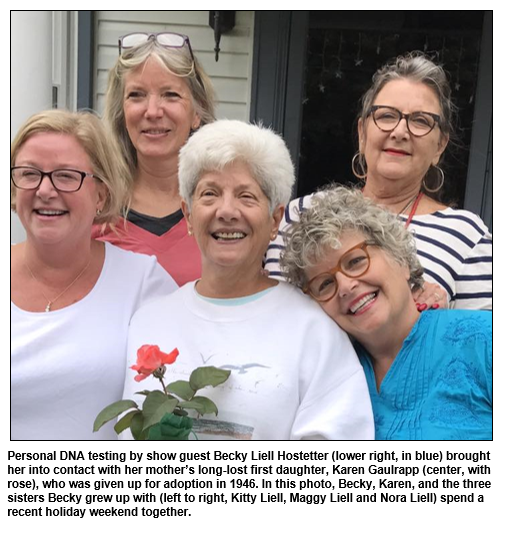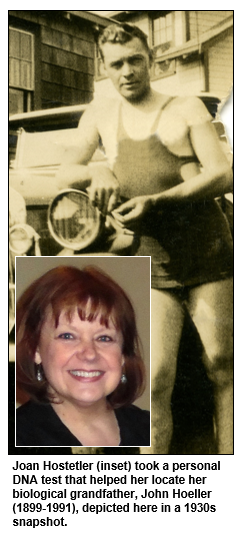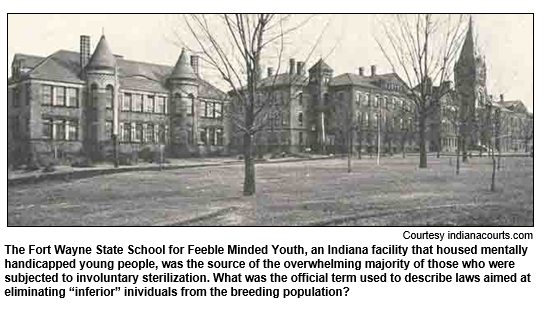Saturdays, noon to 1 p.m. ET on WICR 88.7 FM.
Or listen live from anywhere on WICR Online!
Our call-in number during the show: (317) 788-3314
Did you miss our show, "H.H. Holmes, the 1890s serial killer, and his Indy connections"? Listen to the podcast.
November 4, 2017
Adventures in personal DNA testing

As is clear from the popularity of the show Finding Your Roots, now in its fourth season on PBS, and from the high volume of visitors to the website ancestry.com, many Americans are interested in learning about their family history. And with the advent of personal DNA analysis from services such as 23andMe and AncestryDNA, more and more individuals are learning about the precise admixture of ethnicities in their genetic heritage, as well as discovering possible matches for unknown blood relatives who have undergone the DNA testing themselves.

For this Hoosier History Live show examining what personal DNA testing reveals about ourselves and our shared history, guest host and associate producer Mick Armbruster will interview three Hoosier women who have recently conducted a personal DNA analysis that yielded surprising results. Mick's guests in studio will be:
-
Joan Hostetler, a photo historian and founding director of The Indiana Album. She had her DNA analyzed in 2015 and learned some surprising things about the ancestry of her mother, who had been adopted as an infant in 1927. Joan's mother knew only that she had been born in Fort Wayne, Ind., and that her birth mother, Joan's biological grandmother, had identified herself as a musician and requested that the baby she was giving up eventually be given piano lessons.
Despite years of searching, Joan and her mother were unable to learn the names of Joan's maternal biological grandparents before Joan's mother passed away in 2005.
- Becky Hostetter, a vegetarian chef and co-owner of Duos Indy, whose genetic testing connected her to a long-lost half sibling. As Becky had known for years, her mother had gotten pregnant while serving in the Women's Army Corps during WWII at Camp Ritchie, Md., and had given the baby up for adoption.
In the 1970s Becky and her mother attempted to find the adopted sibling, but to no avail. What little information they had about the person could be summed up on a 3x5 index card: Female, weighed less than 6 lbs. at birth, reddish hair and born May 30, 1946, in a military hospital in New Hempstead, N.Y.
Becky's 2015 DNA test eventually led to locating this long-lost sister and a joyful reunion (including Becky's three other sisters) in 2017. But that wasn't the only surprise: Becky's DNA testing exposed other family secrets about her biological parentage and ethnic heritage.
Maxine Brown, a historian and preservationist from Corydon, Ind., and founder of the Leora Brown School renovation project, which restored one of Indiana's oldest African-American schools. Before DNA analysis she knew of her ancestors who came into Indiana Territory in 1814 with a group of nearly one hundred enslaved people. They were accompanied by an elderly white Anglican couple, Paul and Susannah Mitchem, who originally were from Virginia. The Mitchems were abolitionists whose goal was to bring former slaves into the nominally free territory of Indiana. Maxine's great-great-great grandmother Milly and her five children came into the Indiana Territory as a part of this group.
When Maxine had her DNA tested earlier this year, however, she was surprised to learn that despite identifying as African American throughout her life, her genetic heritage is more Irish than any other ethnic group. She also discovered that her white great great grandfather, John Wimp Jr., (1838-63) was a slaveholder and fathered her great-grandmother, Emeline Wimp Brown. Through genealogy groups, Maxine has been in touch with many of her white Wimp relatives, who she says call her "cousin" as a term of affection.
We'll be taking calls during the second half of the show, so if you've had your DNA tested and were surprised by what you learned, be sure to give us a call at (317) 788-3314.
Learn more:
- "Understanding the process" - a video of Meredith Hurston's results from using 23 and Me.
- "Personal Genetic Testing Is Here; Do We Need It?" - an article from the New York Times.
History Mystery

In 1907, the Indiana state legislature passed a law that provided for the involuntary sterilization of "confirmed criminals, idiots, imbeciles and rapists." The law, which was later found to be unconstitutional and was repealed in 1974, was the first recorded sterilization law in world history and, according to some historians, served as a model for similar laws in Nazi Germany during the 1930s.
During the time when the Indiana sterilization law was active, more than 2,300 Indiana citizens deemed "mental defectives" by the state were involuntarily deprived of their ability to have children.
Question: What was the official term for the "science" (now regarded as pseudoscience) of improving the human population through forced sterilization? Hint: the word is based on the Greek roots for "well" and "born."
The call-in number is (317) 788-3314. Please do not call into the show until you hear Mick pose the question on the air, and please do not try to win if you have won any other prize on WICR during the last two months. You must be willing to give your first name to our engineer, you must answer the question correctly on the air and you must be willing to give your mailing address to our engineer, so we can mail the prize pack to you.
The prize is four tickets to the Indy International Festival on Nov. 9, 10, and 11, courtesy of the Nationalities Council of Indiana; a gift certificate to Story Inn, courtesy of Story Inn; and two admissions to the Indiana History Center, courtesy of the Indiana Historical Society.
Roadtrip: Completed east wing of Lanier Mansion in Madison

Kisha Tandy of the Indiana State Museum and Historic Sites recommends a Roadtrip to the Lanier Mansion in the town of Madison in southern Indiana on the Ohio River. Since 1926 the mansion has been a museum dedicated to the story of its builder and original owner, James F. D. Lanier (1800-81), a financier who is credited with starting the first railroad in Indiana. He also helped stabilize the finances of Indiana on three separate occasions, including a series of loans to the state totaling more than $1million during the Civil War.
The Lanier Mansion, completed in 1844, is one of the best examples of Greek Revival architecture in the country and is considered to be the crown jewel of Madison's Historic District. Designed by architect Francis Costigan, the mansion exhibits many original Greek Revival features, including its square plan, the full-façade porch on the south elevation, the Corinthian columns on the south portico, the Doric pilasters that appear on several locations on the exterior, the ornamental pediments over the windows and doors and the Ionic columns that separate the double parlors on the first floor.
Careful interior restoration and redecoration have recaptured the mansion's 19th-century splendor. During the 1990s, the Department of Natural Resources Division of Museums and Historic Sites, with major funding provided by the Lanier Mansion Foundation, restored the building and grounds to their former grandeur. After many years of painstaking research, the home was painted in the original colors both inside and out. On the interior, horsehair brushes were used to paint the walls and decorative plaster moldings, which were then covered with a high-gloss varnish as they were in 1844. The wallpapers and carpets all are reproductions of those available for purchase in the 1840s. Curators and other staff continue to research furnishings from the period, and changes to reflect their research may be made to the home in the future.
And now, for the first time in the past 100 years, the east wing of the Lanier Mansion has been opened to the public, restored to its appearance at the time Lanier lived in the home.
"The restoration has taken more than 20 years, involving painstaking research, physical reconstruction and plenty of community involvement," Kisha says, and the results are well worth a visit.
Charity music event at historic Alford House
Hoosier History Live senior tech consultant Richard Sullivan invites listeners and readers to his third annual benefit for FACE Low-Cost Animal Clinic. The Nov. 11 Fall Bash Dance Party features the Gordon Bonham Band performing an evening of "rump-shaking blues-rock" at the historic Alford House, 2428 E. 10th Street in Indianapolis. The event will be from 7:30 p.m. to midnight. Tickets are $20 in advance, $25 day of show.
The historic Alford House, which is newly opened as an event center, was built in 1898 by Marion County Criminal Court Judge Fremont Alford and later became a funeral home for many decades.
The event will benefit FACE (Foundation Against Companion-Animal Euthanasia), the near-eastside charity veternary clinic that has performed more than 250,000 animal spay/neuters and other surgeries since its opening in 1999. A newly constructed expansion building is set to open in February.
"My admiration for the work of FACE is boundless," says Richard, who while a reporter at The Indianapolis News wrote stories about FACE founder Scott Robinson, an emergency-room physician who became an animal rights advocate during his doctor training. "They are responsible for reducing the companion-animal (dogs and cats) euthanasia rate in Indianapolis from more than 22,000 per year before their founding to fewer than 3,000 per year today. And they had to fight city hall and established interests to do it.
"Without FACE," Richard continues, "it is estimated that 50,000 dogs and cats would be euthanized in Indianapolis annually," based on human/pet population growth formulas.
Hoosier History Live producer Molly Head will be working the door at the beginning of this event, and our associate producer Mick Armbruster will be there to close out the evening. Stop on by and say hello!
Nelson Price, host and historian
Molly Head, producer/project manager, (317) 927-9101
Michael Armbruster, associate producer
Cheryl Lamb, marketing and administrative manager
Richard Sullivan, senior tech consultant
Pam Fraizer, graphic designer
Garry Chilluffo, special events consultant
Please tell our sponsors that you appreciate their support!

 Acknowledgments to Monomedia, Visit Indy, WICR-FM, Fraizer Designs, Heritage Photo & Research Services, Henri Pensis, Chris Shoulders and many other individuals and organizations. We are an independently produced program and are self-supporting through organizational sponsorships and individual contributions. We do not receive any government funding. Visit our website to learn how you can support us financially. Also, see our Twitter feed and our Facebook page for regular updates.
Acknowledgments to Monomedia, Visit Indy, WICR-FM, Fraizer Designs, Heritage Photo & Research Services, Henri Pensis, Chris Shoulders and many other individuals and organizations. We are an independently produced program and are self-supporting through organizational sponsorships and individual contributions. We do not receive any government funding. Visit our website to learn how you can support us financially. Also, see our Twitter feed and our Facebook page for regular updates.
Thank you!
We'd like to thank the following recent, new and renewal contributors whose donations help make this show possible!
- Dan Carpenter.
- Gary BraVard.
- Beth Newman.
November 11, 2017 - upcoming
World War II and Hoosiers: special perspectives
Despite orders to soldiers during World War II to not write diaries, Roscoe "Rocky" Boyer, who grew up on a farm in Clinton County, Ind., secretly kept one anyway. He became an officer with a fighter bomber unit in the South Pacific.

As a salute to Veteran's Day, Hoosier History Live will explore their written accounts from the front lines, as well as related insights about Hoosiers' role in World War II. Nelson will be joined by two guests:
-
Allen Boyer, a New York-based author and historian who is the son of Rocky Boyer (1919-2008). He has drawn on his father's unauthorized diary as the basis for a new book, Rocky Boyer's War (Naval Institute Press); it describes the diary as "full of (accounts of) casualties, accidents, off-duty shenanigans and rear-area snafus."
-
And Ray Boomhower of the Indiana Historical Society, an author, historian and editor whose newest book is Dispatches from the Pacific: The World War II Reporting of Robert Sherrod (IU Press, 2017). Ray also is the author of The Soldier's Friend: A Life of Ernie Pyle (Indiana Historical Society Press, 2006).
In June 1941, Rocky Boyer was drafted the morning after he graduated from Franklin College. His diary reads: "My first day out in the cold, cruel world. Yes, the draft got me - and how!"
His service took him from Indiana to New Guinea, where he wrote about wartime camp life at one of the world's largest air bases, and the Philippines. Rocky Boyer became a first lieutenant and participated in a major air blitz regarded as pivotal for the Allied victory in the southwest Pacific.
Ernie Pyle, the son of sharecroppers from Dana in far-western Indiana, did not live to celebrate the war's end, but his colleague Robert Sherrod (who was not a Hoosier) did. Upon learning of Japan's surrender, Sherrod, who was embedded with the Marines, wrote: "Many refused to believe it. Sitting in stunned silence, we remembered our dead. So many dead. So many maimed." Hoosier History Live explored Pyle's columns about Indiana - as well as those of journalist John Bartlow Martin, an Indianapolis native - during a show in May 2015. You can listen to audio of that show by visiting our website at hoosierhistorylive.org, or click here for a direct link.
© 2017 Hoosier History Live. All rights reserved.
|





